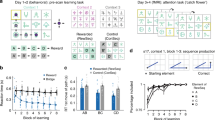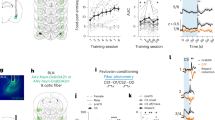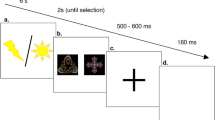Abstract
Experimental research controls for past experience, yet prior experience influences how we learn. Here, we tested whether we could recruit a neural population that usually encodes rewards to encode aversive events. Specifically, we found that GABAergic neurons in the lateral hypothalamus (LH) were not involved in learning about fear in naïve rats. However, if these rats had prior experience with rewards, LH GABAergic neurons became important for learning about fear. Interestingly, inhibition of these neurons paradoxically enhanced learning about neutral sensory information, regardless of prior experience, suggesting that LH GABAergic neurons normally oppose learning about irrelevant information. These experiments suggest that prior experience shapes the neural circuits recruited for future learning in a highly specific manner, reopening the neural boundaries we have drawn for learning of particular types of information from work in naïve subjects.
This is a preview of subscription content, access via your institution
Access options
Access Nature and 54 other Nature Portfolio journals
Get Nature+, our best-value online-access subscription
$29.99 / 30 days
cancel any time
Subscribe to this journal
Receive 12 print issues and online access
$209.00 per year
only $17.42 per issue
Buy this article
- Purchase on Springer Link
- Instant access to full article PDF
Prices may be subject to local taxes which are calculated during checkout







Similar content being viewed by others
Data availability
The data that support the findings of this study, and any associated custom programs used for its acquisition, are available from the corresponding authors upon reasonable request.
Code availability
Simulations were performed using custom-written functions in MATLAB (MathWorks), available on GitHub at https://github.com/mphgardner/LH_Inact_Model/.
References
Axelrod, R. Schema theory: an information processing model of perception and cognition. Am. Polit. Sci. Rev. 67, 1248–1266 (1973).
Bem, S. L. Gender schema theory and its implications for child development: raising gender-aschematic children in a gender-schematic society. Signs J. Women Cult. Soc. 8, 598–616 (1983).
Rumelhart, D. E. Schemata: the building blocks of cognition. in Theoretical Issues in Reading Comprehension: Perspectives from Cognitive Psychology, Linguistics, Artificial Intelligence and Education. 2nd edn (eds Bruce, B. C., Spiro, R. J. & Brewer, W. F.) 33–58 (Routledge, 2017).
Rau, V., DeCola, J. P. & Fanselow, M. S. Stress-induced enhancement of fear learning: an animal model of post-traumatic stress disorder. Neurosci. Biobehav. Rev. 29, 1207–1223 (2005).
Rau, V. & Fanselow, M. S. Exposure to a stressor produces a long lasting enhancement of fear learning in rats. Stress 12, 125–133 (2009).
Sillivan, S. E. et al. Susceptibility and resilience to post-traumatic stress disorder–like behaviors in inbred mice. Biol. Psychiatry 82, 924–933 (2017).
Holmes, N. M., Parkes, S. L., Killcross, A. S. & Westbrook, R. F. The basolateral amygdala is critical for learning about neutral stimuli in the presence of danger, and the perirhinal cortex is critical in the absence of danger. J. Neurosci. 33, 13112–13125 (2013).
Ponomarev, I., Rau, V., Eger, E. I., Harris, R. A. & Fanselow, M. S. Amygdala transcriptome and cellular mechanisms underlying stress-enhanced fear learning in a rat model of post-traumatic stress disorder. Neuropsychopharmacology 35, 1402–1411 (2010).
Nieh, E. H. et al. Inhibitory input from the lateral hypothalamus to the ventral tegmental area disinhibits dopamine neurons and promotes behavioral activation. Neuron 90, 1286–1298 (2016).
Sharpe, M. J. et al. Lateral hypothalamic GABAergic neurons encode reward predictions that are relayed to the ventral tegmental area to regulate learning. Curr. Biol. 27, 2089–2100 (2017).
Stuber, G. D. & Wise, R. A. Lateral hypothalamic circuits for feeding and reward. Nat. Neurosci. 19, 198–205 (2016).
Urstadt, K. R. & Berridge, K. C. Optogenetic mapping of feeding and self-stimulation within the lateral hypothalamus of the rat. PLoS ONE 15, e0224301 (2020).
Margules, D. & Olds, J. Identical ‘feeding’ and ‘rewarding’ systems in the lateral hypothalamus of rats. Science 135, 374–375 (1962).
Sutton, R. S. & Barto, A. G. in Proceedings of the Ninth Annual Conference of the Cognitive Science Society. 355–378 (Seattle, WA).
Seijen, H. & Sutton, R. in Proceedings of the 31st International Conference on Machine Learning. 692–700 (2014).
Sharpe, M. J. & Killcross, S. The prelimbic cortex directs attention toward predictive cues during fear learning. Learn. Mem. 22, 289–293 (2015).
Sharpe, M. J. & Killcross, S. Modulation of attention and action in the medial prefrontal cortex of rats. Psychol. Rev. 125, 822–843 (2018).
Mackintosh, N. J. A theory of attention: variations in the associability of stimuli with reinforcement. Psychol. Rev. 82, 276–298 (1975).
Gardner, M. P. et al. Medial orbitofrontal inactivation does not affect economic choice. Elife 7, e38963 (2018).
Chang, C. Y., Gardner, M. P., Conroy, J. C., Whitaker, L. R. & Schoenbaum, G. Brief, but not prolonged, pauses in the firing of midbrain dopamine neurons are sufficient to produce a conditioned inhibitor. J. Neurosci. 38, 8822–8830 (2018).
Sharpe, M. J. et al. Dopamine transients do not act as model-free prediction errors during associative learning. Nat. Commun. 11, 1–10 (2020).
Sharpe, M. J., Batchelor, H. M. & Schoenbaum, G. Preconditioned cues have no value. Elife 6, e28362 (2017).
Sharpe, M. J. et al. Dopamine transients are sufficient and necessary for acquisition of model-based associations. Nat. Neurosci. 20, 735 (2017).
Langdon, A. J., Sharpe, M. J., Schoenbaum, G. & Niv, Y. Model-based predictions for dopamine. Curr. Opin. Neurobiol. 49, 1–7 (2018).
Holland, P. C. CS–US interval as a determinant of the form of Pavlovian appetitive conditioned responses. J. Exp. Psychol. Anim. Behav. Process. 6, 155–174 (1980).
Lavin, M. J. The establishment of flavor–flavor associations using a sensory preconditioning training procedure. Learn. Motiv. 7, 173–183 (1976).
Killcross, A., Dickinson, A. & Robbins, T. Effects of the neuroleptic α-flupenthixol on latent inhibition in aversively-and appetitively-motivated paradigms: evidence for dopamine-reinforcer interactions. Psychopharmacology 115, 196–205 (1994).
Lubow, R. & Moore, A. Latent inhibition: the effect of nonreinforced pre-exposure to the conditional stimulus. J. Comp. Physiol. Psychol. 52, 415–419 (1959).
Lubow, R. E. & Gewirtz, J. C. Latent inhibition in humans: data, theory and implications for schizophrenia. Psychol. Bull. 117, 87–103 (1995).
Jennings, J. H., Rizzi, G., Stamatakis, A. M., Ung, R. L. & Stuber, G. D. The inhibitory circuit architecture of the lateral hypothalamus orchestrates feeding. Science 341, 1517–1521 (2013).
Fanselow, M. S. & LeDoux, J. E. Why we think plasticity underlying Pavlovian fear conditioning occurs in the basolateral amygdala. Neuron 23, 229–232 (1999).
Maren, S. Neurotoxic basolateral amygdala lesions impair learning and memory but not the performance of conditional fear in rats. J. Neurosci. 19, 8696–8703 (1999).
Ressler, R. L. & Maren, S. Synaptic encoding of fear memories in the amygdala. Curr. Opin. Neurobiol. 54, 54–59 (2019).
Holland, P. C. & Rescorla, R. A. Second-order conditioning with food unconditioned stimulus. J. Comp. Physiol. Psychol. 88, 459–467 (1975).
Rizley, R. C. & Rescorla, R. A. Associations in second-order conditioning and sensory preconditioning. J. Comp. Physiol. Psychol. 81, 1–11 (1972).
Brogden, W. J. Sensory pre-conditioning. J. Exp. Psychol. 25, 323–332 (1939).
Ersche, K. D. et al. Carrots and sticks fail to change behavior in cocaine addiction. Science 352, 1468–1471 (2016).
Everitt, B. J. & Robbins, T. W. Neural systems of reinforcement for drug addiction: from actions to habits to compulsion. Nat. Neurosci. 8, 1481–1489 (2005).
Corlett, P. R. & Fletcher, P. C. Delusions and prediction error: clarifying the roles of behavioural and brain responses. Cogn. Neuropsychiatry 20, 95–105 (2015).
Powers, A. R., Mathys, C. & Corlett, P. Pavlovian conditioning-induced hallucinations result from overweighting of perceptual priors. Science 357, 596–600 (2017).
Mahn, M., Prigge, M., Ron, S., Levy, R. & Yizhar, O. Biophysical constraints of optogenetic inhibition at presynaptic terminals. Nat. Neurosci. 19, 554–556 (2016).
Howell, D. C. Statistical Methods for Psychology. (Cengage Learning, 2012).
Jones, J. L. et al. Orbitofrontal cortex supports behavior and learning using inferred but not cached values. Science 338, 953–956 (2012).
Loftus, G. R. & Masson, M. E. Using confidence intervals in within-subject designs. Psychon. Bull. Rev. 1, 476–490 (1994).
Franz, V. H. & Loftus, G. R. Standard errors and confidence intervals in within-subjects designs: Generalizing Loftus and Masson (1994) and avoiding the biases of alternative accounts. Psychon. Bull. Rev. 19, 395–404 (2012).
Acknowledgements
The authors thank M. Morales and C. Mejias-Aponte for their assistance. This work was supported by grant R01-MH098861 (to G.S.), the Intramural Research Program at the National Institute on Drug Abuse (ZIA-DA000587 to G.S.) and a National Health and Medical Research Council CJ Martin Fellowship (to M.J.S.). The opinions expressed in this article are the authors’ own and do not reflect the views of the National Institutes of Health/Department of Health and Human Services.
Author information
Authors and Affiliations
Contributions
M.J.S. and G.S. designed the experiments. M.J.S., H.M.B. and L.E.M. collected the data. M.J.S. analyzed the data, and M.J.S. and M.P.H.G. conducted the modeling. M.J.S. and G.S. interpreted the data and wrote the manuscript with input from all authors.
Corresponding authors
Ethics declarations
Competing interests
The authors declare no competing interests.
Additional information
Peer review information Nature Neuroscience thanks Stan Floresco and the other, anonymous, reviewer(s) for their contribution to the peer review of this work.
Publisher’s note Springer Nature remains neutral with regard to jurisdictional claims in published maps and institutional affiliations.
Extended data
Extended Data Fig. 1 Histological verification of Cre-dependent NpHR and eYFP in GAD+ neurons and fiber placement in the LH for all experiments.
Top row: Unilateral representation of the bilateral viral expression in the LH, -2mm to -3mm posterior to bregma. Bottom row: Approximate location of fiber tips in LH, indicated by black squares, -2mm to -3mm posterior to bregma.
Extended Data Fig. 2 Rats in our NpHR learners group showed a persistent increase in conditioned fear to the contextual cues, which extinguished before tone presentations in the extinction test.
During conditioning, our NpHR learners group showed high levels of fear to the background contextual cues (left; see Fig. 3 in main text for more information). To reduce these levels of context fear before the test, 24 hours after conditioning, rats received a context extinction session where they were placed in the experimental chambers without any stimuli. Here, we found that our NpHR learners group maintained higher level of context fear relative to our eYFP learners group (middle). This context extinction was effective in reducing contextual fear as all rats showed low levels of freezing at the beginning of the next test session, where we presented the tone under extinction to examine fear that had acquired to these stimuli (right). A mixed-design repeated-measures ANOVA on levels of freezing to the contextual cues across the context and tone extinction sessions showed a main effect of time (F14,140 = 4.614, p = 0.000), and a significant session x time x group interaction (F14,140 = 1.697, p = 0.032). This interaction was owed to a between-group difference in freezing during context extinction that revealed itself most prominently towards the end of the scoring period (group: F1,10 = 5.939, p = 0.035), that was not seen in the tone extinction test (group: F1,10 = 0.007, p = 1.000). Further, there was a significant difference in freezing exhibited by the NpHR group when comparing the context extinction session with the tone test (n = 6 rats; F1,10 = 8.071, p = 0.018), that was not present in the eYFP control group (n = 6 rats; F1,10 = 1.161, p = 0.307). Finally, a one-way ANOVA showed there was no between-group difference in freezing to the context immediately before tone presentations in the tone test after context extinction had taken place (F1,10 = 1.943, p = 0.194). Error bars = SEM.
Extended Data Fig. 3 Responding during conditioning in the second-order conditioning experiment (see Fig. 4 main text).
Rates of responding are represented as time spent in the food port (%; ±SEM). Rats (n = 12 eYFP; n = 8 NpHR) learnt to distinguish between A2 and B2 during conditioning, with no difference in the rates of learning between groups (note: patch cords were placed on rats in session 6 of conditioning to habituate them to the cords prior to pairings of A1→A2 and B1→B2, which is why there is a dip in responding). A repeated-measures ANOVA revealed a main effect of stimulus (F1,18 = 12.383, p = 0.002) and session (session: F6,108 = 10.799, p = 0.424), with no interactions by group (stimulus x group: F1,18 = 1.151, p = 0.298; session x group: F6,108 = 1.008, p = 0.424; stimulus x session: F6,108 = 5.440, p = 0.000; stimulus x session x group: F6,108 = 0.233, p = 0.965).
Extended Data Fig. 4 Responding during conditioning in the sensory-preconditioning experiment (see Fig. 5 main text).
Rates of responding are represented as time spent in the food port (%; ±SEM). Rats (n = 12 eYFP, n = 8 NpHR) learnt to distinguish between A2 and B2 during conditioning, with no difference in the rates or ultimate levels of learning between groups A repeated-measures ANOVA revealed a main effect of stimulus (F1,18 = 3.553, p = 0.076), and a stimulus x session interaction (F2,36 = 8.281, p = 0.001; stimulus × group: F1,18 = 0.13, p = 0.911), with follow-up comparisons, granted by the significant stimulus x session interaction, showing an increase in learning about A2 across sessions (F2,17 = 8.860, p = 0.002), that was not present with relation to B2 (F2,17 = 1.953, p = 0.172).
Supplementary information
Rights and permissions
About this article
Cite this article
Sharpe, M.J., Batchelor, H.M., Mueller, L.E. et al. Past experience shapes the neural circuits recruited for future learning. Nat Neurosci 24, 391–400 (2021). https://doi.org/10.1038/s41593-020-00791-4
Received:
Accepted:
Published:
Issue Date:
DOI: https://doi.org/10.1038/s41593-020-00791-4
This article is cited by
-
Rewarding-unrewarding prediction signals under a bivalent context in the primate lateral hypothalamus
Scientific Reports (2023)
-
Liraglutide restores impaired associative learning in individuals with obesity
Nature Metabolism (2023)
-
Dopamine signaling in the nucleus accumbens core mediates latent inhibition
Nature Neuroscience (2022)
-
The prediction-error hypothesis of schizophrenia: new data point to circuit-specific changes in dopamine activity
Neuropsychopharmacology (2022)
-
Learning is a matter of history and relevance for lateral hypothalamus
Nature Neuroscience (2021)



